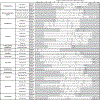Antimicrobial susceptibility testing and successful treatment of hospitalised patients with extensively drug-resistant Campylobacter jejuni infections linked to a pet store puppy outbreak
- PMID: 34048979
- PMCID: PMC8448951
- DOI: 10.1016/j.jgar.2021.04.029
Antimicrobial susceptibility testing and successful treatment of hospitalised patients with extensively drug-resistant Campylobacter jejuni infections linked to a pet store puppy outbreak
Abstract
Objectives: Most patients with Campylobacter infection do not require antibiotics; however, they are indicated in severe cases. Clinical breakpoints for many antibiotics are not yet established by the CLSI, making antibiotic selection for resistant infections challenging. During an outbreak of pet store puppy-associated XDR Campylobacter jejuni infections resistant to seven antibiotic classes, several patients required antibiotics. This study aimed to determine MICs of the outbreak strain for various antibiotics and describes the successful treatment of two patients using imipenem/cilastatin, a drug not traditionally used for Campylobacter infections.
Methods: We used whole-genome multilocus sequence typing (wgMLST) to determine the genetic relatedness of Campylobacter isolates collected from two human patients' stool samples with the outbreak strain. We performed extended antimicrobial susceptibility testing on 14 outbreak isolates and 6 control strains to determine MICs for 30 antibiotics (14 classes).
Results: Isolates from both patients were highly related to the outbreak strain by wgMLST. MICs indicated resistance of the outbreak strain to most antibiotic classes, except phenicols, glycylcyclines and carbapenems. Due to potential side effects of phenicols and safety issues precluding use of glycylcyclines such as tigecycline when alternatives agents are available, we used carbapenems to treat patients who were severely ill from the outbreak strain infections.
Conclusion: Stewardship and clinical vigilance are warranted when deciding whether and how to treat patients with suspected C. jejuni diarrhoea with antibiotics. Clinicians should maintain a high index of suspicion for XDR Campylobacter when patients fail to improve and consider the use of carbapenems in such settings.
Keywords: Campylobacter jejuni; Emerging infection; Extensively drug-resistant; XDR; Zoonosis.
Copyright © 2021 The Author(s). Published by Elsevier Ltd.. All rights reserved.
Conflict of interest statement
Declaration of Competing Interest None declared.
Figures


Similar articles
-
Comparison of Molecular Subtyping and Antimicrobial Resistance Detection Methods Used in a Large Multistate Outbreak of Extensively Drug-Resistant Campylobacter jejuni Infections Linked to Pet Store Puppies.J Clin Microbiol. 2020 Sep 22;58(10):e00771-20. doi: 10.1128/JCM.00771-20. Print 2020 Sep 22. J Clin Microbiol. 2020. PMID: 32719029 Free PMC article.
-
Ongoing Outbreak of Extensively Drug-Resistant Campylobacter jejuni Infections Associated With US Pet Store Puppies, 2016-2020.JAMA Netw Open. 2021 Sep 1;4(9):e2125203. doi: 10.1001/jamanetworkopen.2021.25203. JAMA Netw Open. 2021. PMID: 34524434 Free PMC article.
-
Multidrug-Resistant Campylobacter jejuni Outbreak Linked to Puppy Exposure - United States, 2016-2018.MMWR Morb Mortal Wkly Rep. 2018 Sep 21;67(37):1032-1035. doi: 10.15585/mmwr.mm6737a3. MMWR Morb Mortal Wkly Rep. 2018. PMID: 30235182 Free PMC article.
-
Transmission of multidrug-resistant Campylobacter jejuni to children from different sources in Pakistan.J Glob Antimicrob Resist. 2020 Mar;20:219-224. doi: 10.1016/j.jgar.2019.07.018. Epub 2019 Jul 23. J Glob Antimicrob Resist. 2020. PMID: 31349065
-
Molecular and epidemiologyical analysis of a Campylobacter jejuni outbreak in China, 2018.J Infect Dev Ctries. 2019 Dec 31;13(12):1086-1094. doi: 10.3855/jidc.11408. J Infect Dev Ctries. 2019. PMID: 32088695
Cited by
-
Isolation and Genomic Characteristics of Cat-Borne Campylobacter felis sp. nov. and Sheep-Borne Campylobacter ovis sp. nov.Microorganisms. 2023 Apr 8;11(4):971. doi: 10.3390/microorganisms11040971. Microorganisms. 2023. PMID: 37110394 Free PMC article.
-
Antibiotic susceptibility pattern of Campylobacter sp. isolated from human stool samples including comparison of ellipsoid test and broth microdilution for meropenem.GMS Infect Dis. 2025 Jun 17;13:Doc02. doi: 10.3205/id000092. eCollection 2025. GMS Infect Dis. 2025. PMID: 40709246 Free PMC article.
-
The Missing Pieces: The Role of Secretion Systems in Campylobacter jejuni Virulence.Biomolecules. 2023 Jan 9;13(1):135. doi: 10.3390/biom13010135. Biomolecules. 2023. PMID: 36671522 Free PMC article. Review.
-
Characterisation of burden of illness measures associated with human (Fluoro)quinolone-resistant Campylobacter spp. infections - a scoping review.Epidemiol Infect. 2022 Nov 11;150:e205. doi: 10.1017/S095026882200139X. Epidemiol Infect. 2022. PMID: 36519309 Free PMC article.
-
Epidemiology and Antimicrobial Resistance of Campylobacter Infections in the United States, 2005-2018.Open Forum Infect Dis. 2023 Jul 17;10(8):ofad378. doi: 10.1093/ofid/ofad378. eCollection 2023 Aug. Open Forum Infect Dis. 2023. PMID: 37559755 Free PMC article.
References
-
- US Centers for Disease Control and Prevention (CDC) Campylobacter (campy-lobacteriosis): information for health professionals, Atlanta, GA: CDC; 2020. https://www.cdc.gov/campylobacter/technical.html [accessed 25 October].
-
- Friedman CR, Hoekstra RM, Samuel M, Marcus R, Bender J, Shiferaw B, et al.Emerging Infections Program FoodNet Working Group. Risk factors for sporadic Campylobacter infection in the United States: a case–control study in FoodNet sites. Clin Infect Dis 2004;38(Suppl 3):S285–96. doi: 10.1086/381598. - DOI - PubMed
-
- Marotta F, Garofolo G, di Marcantonio L, Di Serafino G, Neri D, Romantini R, et al.Antimicrobial resistance genotypes and phenotypes of Campylobacter jejuni isolated in Italy from humans, birds from wild and urban habitats, and poultry. PLoS One 2019;14:e0223804. doi: 10.1371/journal.pone.0223804. - DOI - PMC - PubMed
MeSH terms
Substances
Grants and funding
LinkOut - more resources
Full Text Sources
Other Literature Sources
Medical
Molecular Biology Databases

